-
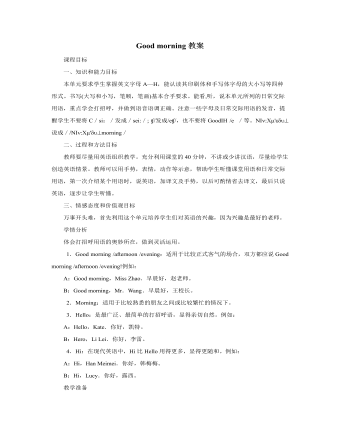
人教版新目标初中英语七年级上册Good morning教案
一、知识和能力目标本单元要求学生掌握英文字母A—H,能认读其印刷体和手写体字母的大小写等四种形式。书写(大写和小写,笔顺,笔画)基本合乎要求。能看,听,说本单元所列的日常交际用语,重点学会打招呼,并做到语音语调正确。注意一些字母及日常交际用语的发音,提醒学生不要将C/si:/发成/sei:/; ?/发成/e?/,也不要将Good?H /e /等。??????'????说成/???????'???morning/二、过程和方法目标教师要尽量用英语组织教学。充分利用课堂的40分钟,不讲或少讲汉语,尽量给学生创造英语情景。教师可以用手势,表情,动作等示意,帮助学生听懂课堂用语和日常交际用语,第一次介绍某个用语时,说英语,加译文及手势,以后可酌情省去译文,最后只说英语,逐步让学生听懂。
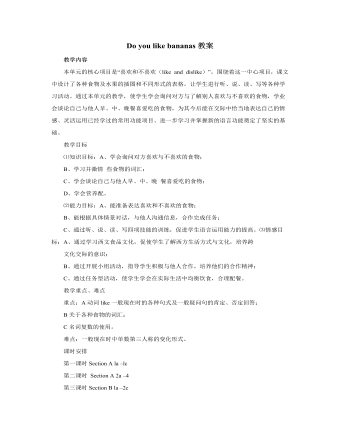
人教版新目标初中英语七年级上册Do you like bananas教案
教学目标 ⑴知识目标:A、学会询问对方喜欢与不喜欢的食物; B、学习并激情 些食物的词汇; C、学会谈论自己与他人早、中、晚 餐喜爱吃的食物; D、学会营养配。 ⑵能力目标:A、能准备表达喜欢和不喜欢的食物; B、能根据具体情景对话,与他人沟通信息,合作完成任务; C、通过听、说、读、写四项技能的训练,促进学生语言运用能力的提高。⑶情感目标:A、通过学习西文食品文化,促使学生了解西方生活方式与文化,培养跨 文化交际的意识; B、通过开展小组活动,指导学生积极与他人合作,培养他们的合作精神; C、通过任务型活动,使学生学会在实际生活中均衡饮食,合理配餐。 教学重点、难点 重点:A动词like一般现在时的各种句式及一般疑问句的肯定、否定回答; B关于各种食物的词汇; C名词复数的使用。 难点:一般现在时中单数第三人称的变化形式。
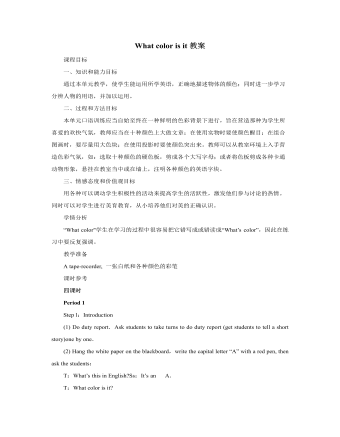
人教版新目标初中英语七年级上册What color is it教案
一、知识和能力目标通过本单元教学,使学生能运用所学英语,正确地描述物体的颜色;同时进一步学习分辨人物的用语,并加以运用。二、过程和方法目标本单元口语训练应当自始至终在一种鲜明的色彩背景下进行,旨在营造那种为学生所喜爱的欢快气氛,教师应当在十种颜色上大做文章;在使用实物时要使颜色醒目;在组合图画时,要尽量用大色块;在使用投影时要使颜色突出来。教师可以从教室环境上入手营造色彩气氛,如:选取十种颜色的硬色板,剪成各个大写字母;或者将色板剪成各种卡通动物形象,悬挂在教室当中或在墙上,注明各种颜色的英语字块。三、情感态度和价值观目标用各种可以调动学生积极性的活动来提高学生的活跃性,激发他们参与讨论的热情。同时可以对学生进行美育教育,从小培养他们对美的正确认识。
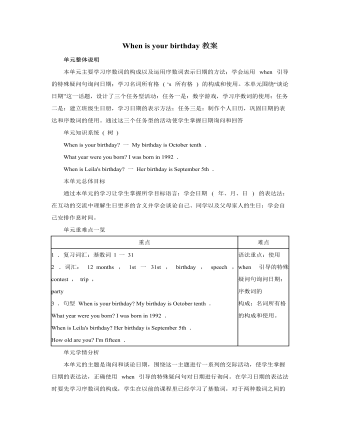
人教版新目标初中英语七年级上册When is your birthday教案
本单元主要学习名词所有格 ('s 所有格 ) 的构成和使用。在初次接触 “ 名词所有格 ” 时,学生较难理解的可能是 “ 所有格 ” 这个名称,对于它的构成,学生也许会觉得较容易。教师可通俗地告诉学生 “ 所有格 ” 的意思是表示 “…… 的 ” ,这样学生反而容易接受。在使用 “ 名词所有格 ” 形式时,学生容易犯错误或混淆的主要是:将这种一 's 构成形式与 is 的缩写形式混淆,如: My father's name's Jin Zhi .,可以这样告诉学生:名词所有格的后面一般应接名词;勿将这种一 's 结构盲目套用与人称代词上,代替物主代词使用,如 He's father's name is Li Cheng 。在教学初期,可不讲授名词所有格的其它形式,待时机成熟,再向学生介绍复数名词所有格形式的结构一 ' ,如: the students' bikes 。 Self Check 教学内容 Self Check( 教材 P52) 教学目标 知识与能力 复习词汇 birthday , date , month , January , February , March , April , May , June , July , August , September , October , November , December , date , birth , age , old , speech . contest . trip , party , event , an , festival , pop , concert , chorus , lecture , music ;引导学生复习、巩固“询问和谈论日期”的目标语言并运用所学知识安排活动。
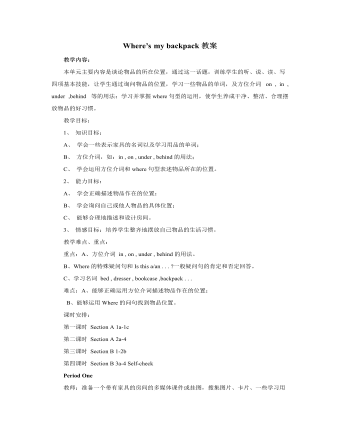
人教版新目标初中英语七年级上册Where’s my backpack教案
教师: 搜集单词卡片、背景资料。 学生:彩笔、大白纸、相关新单词。 教学设计 Step One: Learn the new words. 1.Present the new words. (Show some pictures and words on the screen to teach the students the new words.) T: What’s this? S1: It’s a room. T: Do you have a room like this? S2: Yes, I do./ No, I don’t. T: Read after me. R-O-O-M, room. Ss: R-O-O-M, room. (Teach the other words “TV, desk, picture” in the same way.) T: There are some words here. Read the words after me and spell them. (Learn the other words without pictures on the cards.) T: This is a word. Can you spell this word? (Point to a word in the card.) S1: Yes, I can. / No, I can’t. (Let them know the meaning of “can”.) T: I can spell your name. Can you spell my name? S1: Yes, I can. T: Can you write your name? S: Sorry, I can’t. I have no pen. T: You need a pen.( Give him a pen.) ( Let the students understand the word “need”.) T: I bring a football to school every day. Now it is on the floor. After class I take it to my home. (Teach “bring” and “take”. Put a football on the floor and point to the floor to teach the word “floor”.) 2.Practice the words. (Give the examples to the students and get the students to understand the new words.) Step To Listen and practice.
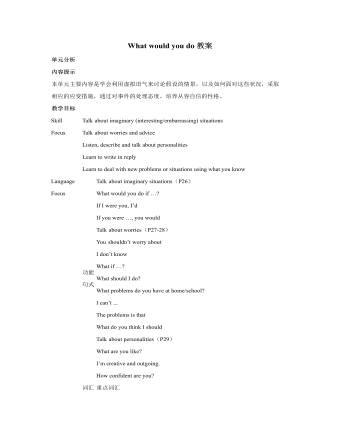
人教版新目标初中英语九年级上册What would you do教案
本课采用任务型教学法,用What would you do if you had a million dollars?这个问句,引出谈论假想情况的话题。 采用提问、启发和归纳的教法,让学生易于接受教材内容,培养学生的语言运用能力。 四、 教学过程设计 Step Ⅰ. Greet the whole class as usual. Step Ⅱ. Warming-up T: Do you have ten Yuan in your pocket? S1: No, I don’t. T: (Take out ten Yuan and give it to the student) OK, never mind. What would you do if it was yours? What would you do if you had ten Yuan? S1: I would buy snacks. T: OK, thank you. Sit down, please. (To the whole class) Just now, it was only ten Yuan. What about 100 Yuan? What would you doif you had 100 Yuan? S2: I’d buy a beautiful jacket. T: Thank you. (To the whole class) Now suppose you had a million dollars, what would you do? We know thatone dollar nearly equals eight Yuan, so that’s a large sum of money. Think it over carefully and tellme your ideas. What would you do if you had a million dollars? S3: I’d buy a big house. S4: I’d buy a sports car. S5: I’d put it in the bank. T: OK, stop here. Please look at the blackboard and guess what would I do if I had a million
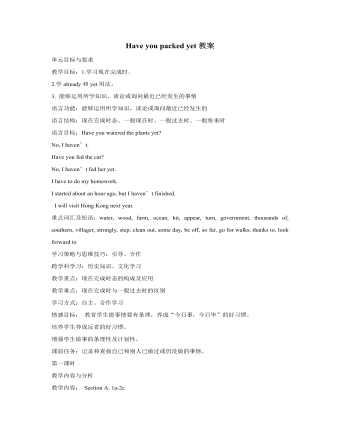
人教版新目标初中英语九年级下册Have you packed yet教案
教学目标:1.学习现在完成时。2.学already和yet用法。3. 能够运用所学知识,谈论或询问最近已经发生的事情语言功能:能够运用所学知识,谈论或询问最近已经发生的语言结构:现在完成时态、一般现在时、一般过去时、一般将来时语言目标:Have you watered the plants yet?No, I haven’t.Have you fed the cat?No, I haven’t fed her yet.I have to do my homework. I started about an hour ago, but I haven’t finished. I will visit Hong Kong next year.重点词汇及短语:water, wood, farm, ocean, hit, appear, turn, government, thousands of, southern, villager, strongly, step, clean out, some day, be off, so far, go for walks, thanks to, look forward to学习策略与思维技巧:引导、合作跨学科学习:历史知识、文化学习教学重点:现在完成时态的构成及应用教学难点:现在完成时与一般过去时的区别 学习方式:自主、合作学习 情感目标: 教育学生做事情要有条理,养成“今日事,今日毕”的好习惯。培养学生养成反省的好习惯。增强学生做事的条理性及计划性。课前任务:记录和查找自己和别人已做过或仍没做的事情。
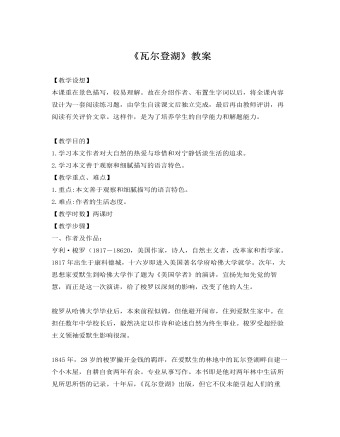
人教版高中语文《瓦尔登湖》教案
【教学步骤】一、作者及作品:亨利·梭罗(1817-18620,美国作家,诗人,自然主义者,改革家和哲学家。1817年出生于康科德城,十六岁即进入美国著名学府哈佛大学就学。次年,大思想家爱默生到哈佛大学作了题为《美国学者》的演讲,宣扬先知先觉的智慧,而正是这一次演讲,给了梭罗以深刻的影响,改变了他的人生。梭罗从哈佛大学毕业后,本来前程似锦,但他避开闹市,住到爱默生家中。在担任数年中学校长后,毅然决定以作诗和论述自然为终生事业。梭罗受超经验主义领袖爱默生影响很深。1845年,28岁的梭罗撇开金钱的羁绊,在爱默生的林地中的瓦尔登湖畔自建一个小木屋,自耕自食两年有余。专业从事写作。本书即是他对两年林中生活所见所思所悟的记录。十年后,《瓦尔登湖》出版,但它不仅未能引起人们的重视,相反还遭到批评和讥讽。然而,随着时光的流逝,这本书的影响却越来越大,终而成为美国文学中的一本独特的、卓越的名著。
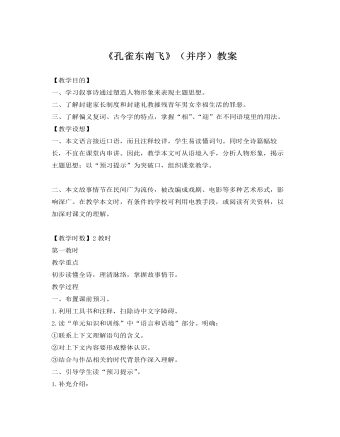
人教版高中语文《孔雀东南飞》教案
3.结合作品的时代背景,进一步理解“黄泉共为友”。故事发生在“汉末建安中”。当时的背景是:汉武帝时,“罢黜百家,独尊儒术”。儒家的那套伦理纲常逐渐占据了统治地位,并发展到了相当完备严密的程度。在婚姻制度方面就规定有“七出”、“天下无不是之父母”等等清规戒律。“天下无不是之父母”,这正是焦、刘悲剧的根本原因。在这一时代氛围里,在焦母的淫威下,焦仲卿敢于站在兰芝一边,表明与兰芝“结发同枕席,黄泉共为友”的坚决态度,实在是难能可贵的。面对儒家所规定的封建家长制度、封建礼教,焦仲卿举起的那面反抗的旗帜,无疑是茫茫长夜中的一道闪电!小结:对语境体察得越充分,对语言理解的深度和广度就越丰富。那么,我们对作品阅读理解的水平就越高。
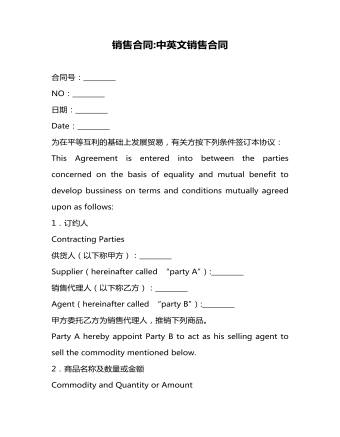
中英文销售合同
在本协议有效期内,乙方在上述经销地区所作广告宣传的一切费用,由乙方自理。乙方须事先向甲方提供宣传广告的图案及文字说明,由甲方审阅同意。
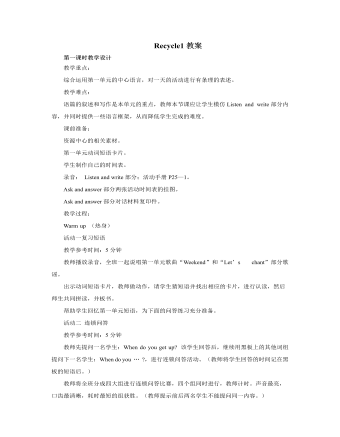
人教版新课标PEP小学英语五年级下册Recycle1教案(内容详细)
学生搜集中外重要节日及部分中外名人的生日所在的月份。教师准备相关节日及部分中外名人的图片或音像资料片。教师课前准备Let’s find out2的配图画好春、夏、秋、冬四个方框。录音:Listen and number。教学过程:Warm up (热身)活动一复习单词教学参考时间:3分钟(1)教师播放Let’s chant部分的歌谣,学生听一遍后跟唱。(2)出示带有各个月份特征的单词卡片。学生看图说出单词,并一起拼读其缩写形式。帮助学生在有节奏的说唱中巩固记忆单词,为在后面活动中学生能够熟练应用作铺垫。活动二 复习句子教学参考时间:5分钟(1)师生同唱Let’s chant部分歌谣“When Is Your Birthday?”。(2)教师引导学生看歌谣下面的翻滚过山车的动画,师生进行问答,如:When is the rabbit’s birthday? It’s in May. 等。教师示范后请学生进行Pair work,也可以展开竞赛的形式进行“连锁问答”。巩固有关生日问答的语句,为Let’s find out1的活动做准备。
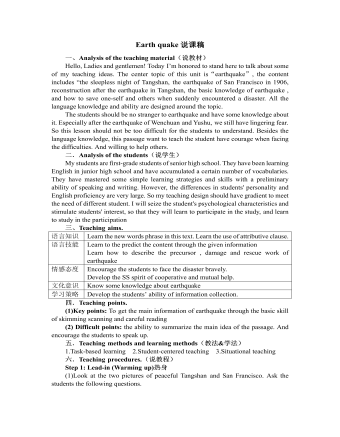
人教版高中英语必修1Earth quake说课稿
(4)Finally, I will ask the SS what this sentence mean:It is always calm before a storm.Purpose: attract the SS attention and bring them into discussionStep 2: Pre-reading 读前Here, I will do the second question in pre-reading first. I will use the method of brainstorming to ask the SS what will happen before an earthquake; and list the phenomenon on the table. 2. Then I will show the SS the picture of abnormal phenomenon, at the same time, encourage the SS to describe.3、finally, I will summarize these phenomenon4、Do the first question in the pre-reading , Imaging your home begins to shake and you must leave it right away. You have time to take only one thing. What will you take? Why?Purpose: help the SS to get further understanding of the topic and stimulate their interests.Step3: While-reading 阅读(1). Skimming Read the text quickly and catch the meaning of the first and second sentence of each paragraph. Predict the meaning of new words(2).scanning(找读)A. Read the text again. Do the following question.1. When and where were the strange things happening?2. What are they?3. Why did the text say the world seemed to be at an end?4. How was the city destroyed after the quake?5. When did the second quake hit the city? What was the result of that?6. Who came to help Tangshan first? And how?B. Work in pairs to discuss the question.
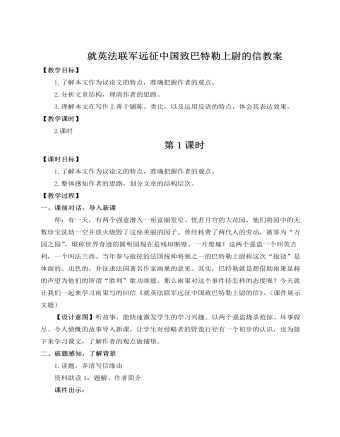
人教部编版语文九年级上册就英法联军远征中国致巴特勒上尉的信教案
【设计意图】以课文为本,积累知识,领会其写法,提高阅读鉴赏能力是必须的,但文中的知识点很多,时间有限,教师不可能面面俱到。故本板块设计侧重反语的表达效果,教师启发引路为辅,学生合作探究为主。三、总结交流,拓展延伸学完本文,我们思绪万千,有对雨果的钦佩,有对英法联军的痛恨,有对清政府的愤懑,有对战争的厌恶……请以《,我想对你说》为题,说一段话,谈谈你的感想。【设计意图】学以致用,才是教学的最好归宿。引导学生与文本中的人、事对话,既可加深学生对所学知识的理解,又可锻炼学生运用知识、独立思考的能力,还能激发为振兴中华而发愤图强的爱国激情。结束语:一代名园圆明园毁灭了,它毁于英法侵略者之手,也毁于清政府的腐败无能。它的毁灭,既是西方侵略者野蛮摧残人类文化的见证,又是文明古国落后也要挨打的证明,我们中华民族不想欺侮其他民族,但也决不能允许别人欺侮我们。少年强,则中国强!同学们,为了中华民族的伟大复兴,为了圆明园类似的悲剧不再发生,我们要勤奋学习,努力奋斗!
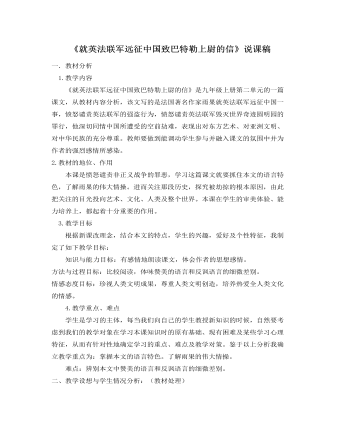
部编版语文九年级上册《就英法联军远征中国致巴特勒上尉的信》说课稿
1.教学内容《就英法联军远征中国致巴特勒上尉的信》是九年级上册第二单元的一篇课文,从教材内容分析,该文写的是法国著名作家雨果就英法联军远征中国一事,愤怒谴责英法联军的强盗行为,愤怒谴责英法联军毁灭世界奇迹圆明园的罪行,他深切同情中国所遭受的空前劫难,表现出对东方艺术、对亚洲文明、对中华民族的充分尊重。教师要做到能调动学生参与并融入课文的氛围中并为作者的强烈感情所感染。2.教材的地位、作用本课是愤怒谴责非正义战争的罪恶,学习这篇课文就要抓住本文的语言特色,了解雨果的伟大情操。进而关注那段历史,探究被劫掠的根本原因,由此把关注的目光投向艺术、文化、人类及整个世界。本课在学生的审美体验、能力培养上,都起着十分重要的作用。3.教学目标根据新课改理念,结合本文的特点,学生的兴趣,爱好及个性特征,我制定了如下教学目标:
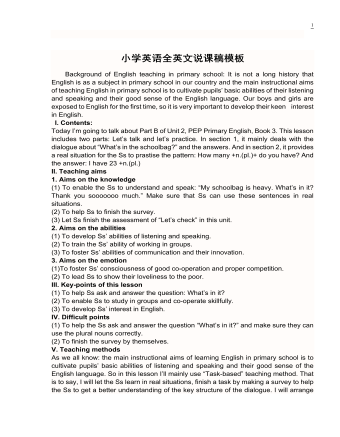
小学英语全英文说课稿模板
1. Aims on the knowledge(1) To enable the Ss tounderstand and speak: “My schoolbag is heavy. What’s in it? Thank you sooooooomuch.” Make sure that Ss can use these sentences in real situations.(2) To help Ss to finish thesurvey.(3) Let Ss finish theassessment of “Let’s check” in this unit.2. Aims on the abilities(1) To develop Ss’ abilitiesof listening and speaking.(2) To train the Ss’ abilityof working in groups.(3) To foster Ss’ abilities ofcommunication and their innovation. 3. Aims on the emotion(1)To foster Ss’ consciousnessof good co-operation and proper competition.(2) To lead Ss to show theirloveliness to the poor.
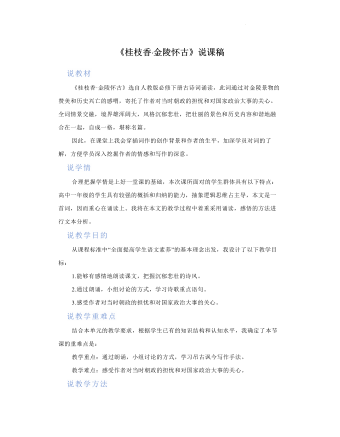
古诗词诵读《桂枝香?金陵怀古》说课稿(一) 2021-2022学年统编版高中语文必修下册
王安石,字介甫,号半山。北宋著名政治家、思想家、文学家、改革家,唐宋八大家之一。欧阳修称赞王安石:“翰林风月三千首,吏部文章二百年。老去自怜心尚在,后来谁与子争先。”传世文集有《王临川集》、《临川集拾遗》等。其诗文各体兼擅,词虽不多,但亦擅长,世人哄传之诗句莫过于《泊船瓜洲》中的“春风又绿江南岸,明月何时照我还。”且有名作《桂枝香》等。介绍之后设置这样的导入语:今天我们共同走进王安石,一起欣赏名作《桂枝香·金陵怀古》。(板书标题)(二)整体感知整体感知是赏析文章的前提,通过初读,可以使学生初步了解将要学到的基本内容,了解文章大意及思想意图,使学生对课文内容形成整体感知。首先,我会让学生根据课前预习,出声诵读课文,同时注意朗读的快慢、停顿、语调、轻重音等,然后再播放音频,纠正他们的读音与停顿。其次,我会引导学生谈谈他感受。学生通过朗读,能够说出本词雄壮、豪放、有气势,有对景物的赞美和对历史的感喟。

古诗词诵读《拟行路难(其四)》说课稿 2021-2022学年统编版高中语文选择性必修下册
(一)导入新课“时势造英雄”,恶劣的环境造就名诗名篇。正因如此,怀才不遇于古人是恒久的情感素材。同学们,请大家回忆我们学过哪些抒发作者怀才不遇的诗词?(二)解释题意拟:仿照,模拟《行路难》,是乐府杂曲,本为汉代歌谣,晋人袁山松改变其音调,创制新词,流行一时。 鲍照《拟行路难》共十八首,歌咏人世的种种忧虑,寄寓悲愤,今天我们学习的是其中第四首。(三)作者简介、写作背景门阀制度之下,“上品无寒门,下品无世族”,出身寒微的文人往往空怀一腔热忱,却报国无门,不得不在壮志未酬的遗恨中坐视时光流逝。即使跻身仕途,也多是充当幕僚、府掾,备受压抑,在困顿坎坷中徒然挣扎,只落得身心交瘁。
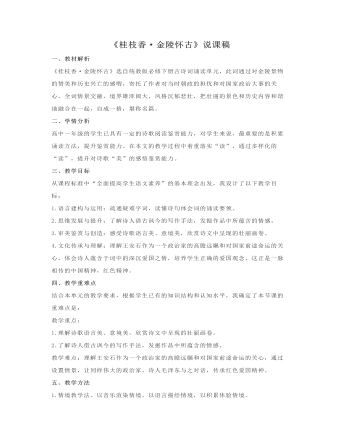
古诗词诵读《桂枝香?金陵怀古》说课稿(二) 2021-2022学年统编版高中语文必修下册
一、教材解析《桂枝香·金陵怀古》选自统教版必修下册古诗词诵读单元,此词通过对金陵景物的赞美和历史兴亡的感喟,寄托了作者对当时朝政的担忧和对国家政治大事的关心。全词情景交融,境界雄浑阔大,风格沉郁悲壮,把壮丽的景色和历史内容和谐地融合在一起,自成一格,堪称名篇。二、学情分析高中一年级的学生已具有一定的诗歌阅读鉴赏能力,对学生来说,最重要的是积累诵读方法,提升鉴赏能力。在本文的教学过程中着重落实“读”,通过多样化的“读”,提升对诗歌“美”的感悟鉴赏能力。三、教学目标从课程标准中“全面提高学生语文素养”的基本理念出发,我设计了以下教学目标:1.语言建构与运用:疏通疑难字词,读懂诗句体会词的诵读要领。
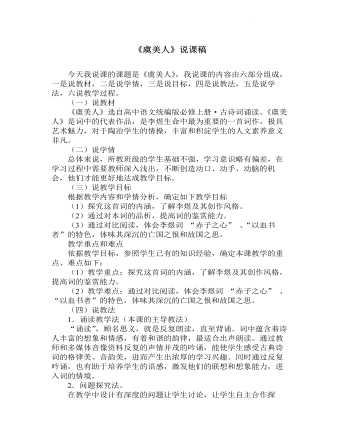
古诗词诵读《虞美人(春花秋月何时了)》说课稿 2021-2022学年统编版高中语文必修上册
(一)说教材 《虞美人》选自高中语文统编版必修上册·古诗词诵读。《虞美人》是词中的代表作品,是李煜生命中最为重要的一首词作,极具艺术魅力,对于陶冶学生的情操,丰富和积淀学生的人文素养意义非凡。(二)说学情总体来说,所教班级的学生基础不强,学习意识略有偏差,在学习过程中需要教师深入浅出,不断创造动口、动手、动脑的机会,他们才能更好地达成教学目标。(三)说教学目标根据教学内容和学情分析,确定如下教学目标(1)探究这首词的内涵,了解李煜及其创作风格。(2)通过对本词的品析,提高词的鉴赏能力。(3)通过对比阅读,体会李煜词 “赤子之心” 、“以血书者”的特色,体味其深沉的亡国之恨和故国之思。
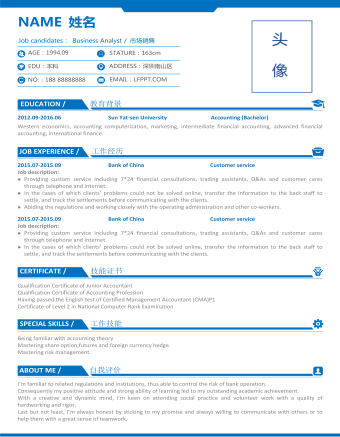
市场营销英文简历
2015.07-2015.09 Bank of China Customer service Job description:lProviding custom service including 7*24 financialconsultations, trading assistants, Q&As and customer cares throughtelephone and internet.lIn the cases of which clients’ problems could not be solvedonline, transfer the information to the back staff to settle, and track thesettlements before communicating with the clients.lAbiding the regulations and working closely with theoperating administration and other co-workers.2015.07-2015.09 Bank of China Customer service Job description:lProviding custom service including 7*24 financialconsultations, trading assistants, Q&As and customer cares throughtelephone and internet.lIn the cases of which clients’ problems could not be solvedonline, transfer the information to the back staff to settle, and track thesettlements before communicating with the clients.


